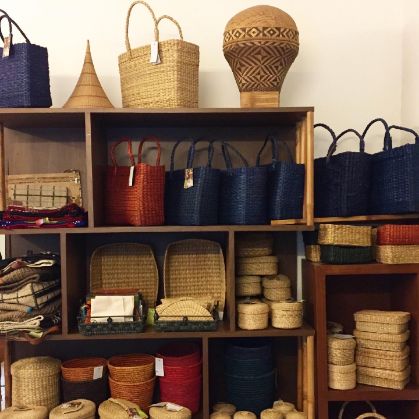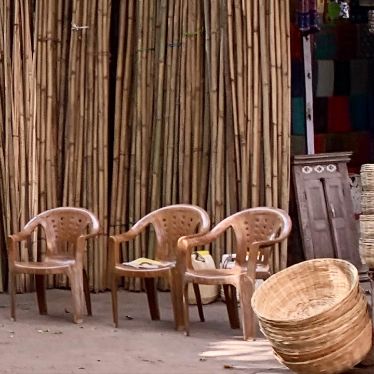












CANE
Across the length and breadth of India, local forests abundant with canes, grasses, reeds and bamboo are the source materials for craftspeople to make a vast array of things essential to their lives, ranging from baskets and storage containers to furniture, fences and even bridges and houses. The choice of materials and techniques used to make them are skills that have been handed down through the generations. Many rural people who work in agriculture create these products to supplement their incomes. There are also professional master craftsmen who are specialists, such as the bamboo flute makers from the town of Pilibhitin, Uttar Pradesh who produce over 95% of India’s flutes.
Many regions have developed unique products to meet the demands of their climate such as in the gloriously beautiful vale of Kashmir in India’s most northerly state, where local people carry a kangri to keep warm in the famously cold winters. This is a wicker basket that surrounds a clay pot containing smouldering coals, and is carried under one’s pheran, a large poncho like overcoat. In Cherrapunji in the Northeast of India the local people have created a rain shield (like a teardrop shaped hat) made from reed bamboo and palm leaves known as a Krup, enabling their hands to be free to continue to work in the fields in what is said to be the wettest place on earth, receiving the world’s heaviest rainfall. In many warmer locations such as Kanyakumari on the Southern tip of India, woven reed mats are widely used to sit or sleep on. They are regarded as cool mats as they don’t induct heat and remain cool to the touch. Pattu pai (silk mats) are made by master weavers in this district. They use kora grass that has been soaked in the Tampraparani River, which enables finer splits so that the resulting mat is as soft as silk.
The environmental and sustainability benefits of bamboo, cane and other reeds have led many contemporary product designers to work with this abundant natural resource and they are partnering with the traditional artisans to produce gorgeous products that are now in demand in the world’s sophisticated urban centres.
“In many tribes the umbilical cord of a new born child is cut with a bamboo knife and the dead are laid to rest on bamboo beds. Bamboo shoots are eaten either roasted and pickled, rice is eaten in bamboo plates and carried in bamboo baskets and rice beer is drunk in bamboo mugs through bamboo drinking straw. Bamboo poles with trimming symbolise religious commitment and are used as decorations on auspicious occasions. Surely the people of the northeastern region can be said to have a bamboo culture.” M P Ranjan
“Design is a way of life. Design is everything we do, every day. Essentially, that means solving a problem with resources that are available where you are. I learned that when I watched craftspeople at work. To me, they were designers before ‘designers’ even existed.” Sandeep Sangaru

CANE
Across the length and breadth of India, local forests abundant with canes, grasses, reeds and bamboo are the source materials for craftspeople to make a vast array of things essential to their lives, ranging from baskets and storage containers to furniture, fences and even bridges and houses. The choice of materials and techniques used to make them are skills that have been handed down through the generations. Many rural people who work in agriculture create these products to supplement their incomes. There are also professional master craftsmen who are specialists, such as the bamboo flute makers from the town of Pilibhitin, Uttar Pradesh who produce over 95% of India’s flutes.
Many regions have developed unique products to meet the demands of their climate such as in the gloriously beautiful vale of Kashmir in India’s most northerly state, where local people carry a kangri to keep warm in the famously cold winters. This is a wicker basket that surrounds a clay pot containing smouldering coals, and is carried under one’s pheran, a large poncho like overcoat. In Cherrapunji in the Northeast of India the local people have created a rain shield (like a teardrop shaped hat) made from reed bamboo and palm leaves known as a Krup, enabling their hands to be free to continue to work in the fields in what is said to be the wettest place on earth, receiving the world’s heaviest rainfall. In many warmer locations such as Kanyakumari on the Southern tip of India, woven reed mats are widely used to sit or sleep on. They are regarded as cool mats as they don’t induct heat and remain cool to the touch. Pattu pai (silk mats) are made by master weavers in this district. They use kora grass that has been soaked in the Tampraparani River, which enables finer splits so that the resulting mat is as soft as silk.
The environmental and sustainability benefits of bamboo, cane and other reeds have led many contemporary product designers to work with this abundant natural resource and they are partnering with the traditional artisans to produce gorgeous products that are now in demand in the world’s sophisticated urban centres.
“In many tribes the umbilical cord of a new born child is cut with a bamboo knife and the dead are laid to rest on bamboo beds. Bamboo shoots are eaten either roasted and pickled, rice is eaten in bamboo plates and carried in bamboo baskets and rice beer is drunk in bamboo mugs through bamboo drinking straw. Bamboo poles with trimming symbolise religious commitment and are used as decorations on auspicious occasions. Surely the people of the northeastern region can be said to have a bamboo culture.” M P Ranjan
“Design is a way of life. Design is everything we do, every day. Essentially, that means solving a problem with resources that are available where you are. I learned that when I watched craftspeople at work. To me, they were designers before ‘designers’ even existed.” Sandeep Sangaru





























